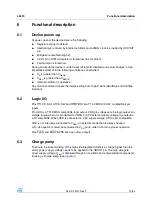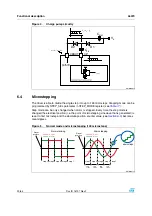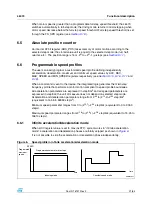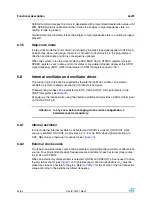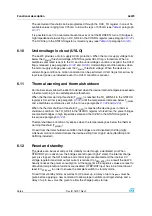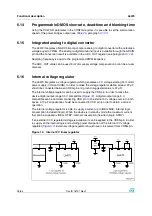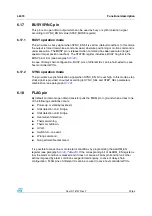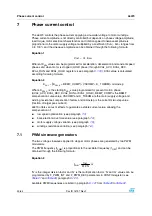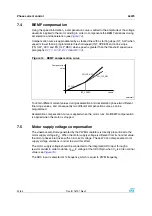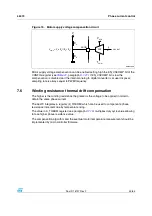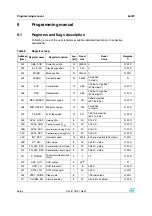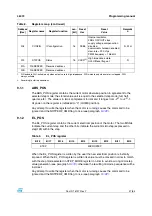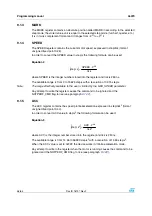
Functional description
L6470
26/64
Doc ID 16737 Rev 2
The overcurrent threshold can be programmed through the OCD_TH register in one of 16
available values ranging from 375 mA to 6 A with steps of 375 mA (see
, paragraph
It is possible to set if an overcurrent event causes or not the MOSFETs turn-off (bridges in
high impedance status)acting on OC_SD bit in the CONFIG register (see paragraph
).
The OCD flag in the STATUS register is raised anyway (see
, paragraph
).
6.10
Undervoltage lock-out (UVLO)
The L6470 provides a motor supply UVLO protection. When the motor supply voltage falls
below the V
SthOff
threshold voltage, STATUS register UVLO flag is forced low. When a
GetStatus command is sent to the IC, and the undervoltage condition is expired, the UVLO
flag is released (see paragraphs
and
). Undervoltage condition expires when
the motor supply voltage goes over the V
SthOn
threshold voltage. When the device is in
undervoltage condition no motion command can be performed. UVLO flag is forced low by
logic reset (power-up included) even if no UVLO condition is present.
6.11
Thermal warning and thermal shutdown
An internal sensor allows the L6470 to detect when the device internal temperature exceeds
a thermal warning or an overtemperature threshold.
When the thermal warning threshold (T
j(WRN)
) is reached the TH_WRN bit in the STATUS
register is forced low (see paragraph
) until the temperature decrease below T
j(WRN)
and a GetStatus command is sent to the IC (see paragraphs
and
).
When the thermal shutdown threshold (T
j(OFF)
) is reached the device goes in thermal
shutdown condition: the TH_SD bit in the STATUS register is forced low, the power bridges
are disabled bridges in high impedance state and the HiZ bit in the STATUS register is
raised (see paragraph
Thermal shutdown condition only expires when the temperature goes below the thermal
warning threshold (T
j(WRN)
).
On exit from thermal shutdown condition the bridges are still disabled (HiZ flag high);
whichever motion command makes the device exiting from High Z state (HardStop and
SoftStop included).
6.12
Reset and standby
The device can be reset and put into standby mode through a dedicated pin. When
STBY\RST pin is driven low, the bridges are left open (High Z state), the internal charge
pump is stopped, the SPI interface and control logic are disabled and the internal 3 V
voltage regulator maximum output current is reduced to I
REG,STBY
; as a result the L6470
heavily reduces the power consumption. At the same time the registers values are reset to
default and all protection functions are disabled. STBY\RST input has to be forced low at
least for t
STBY,min
in order to ensure the complete switch to standby mode.
On exit from standby mode, as well as for IC power-up, a delay of up to t
logicwu
must be
given before applying a new command to allow proper oscillator and logic startup and a
delay of up to t
cpwu
must be given to allow the charge pump startup.








